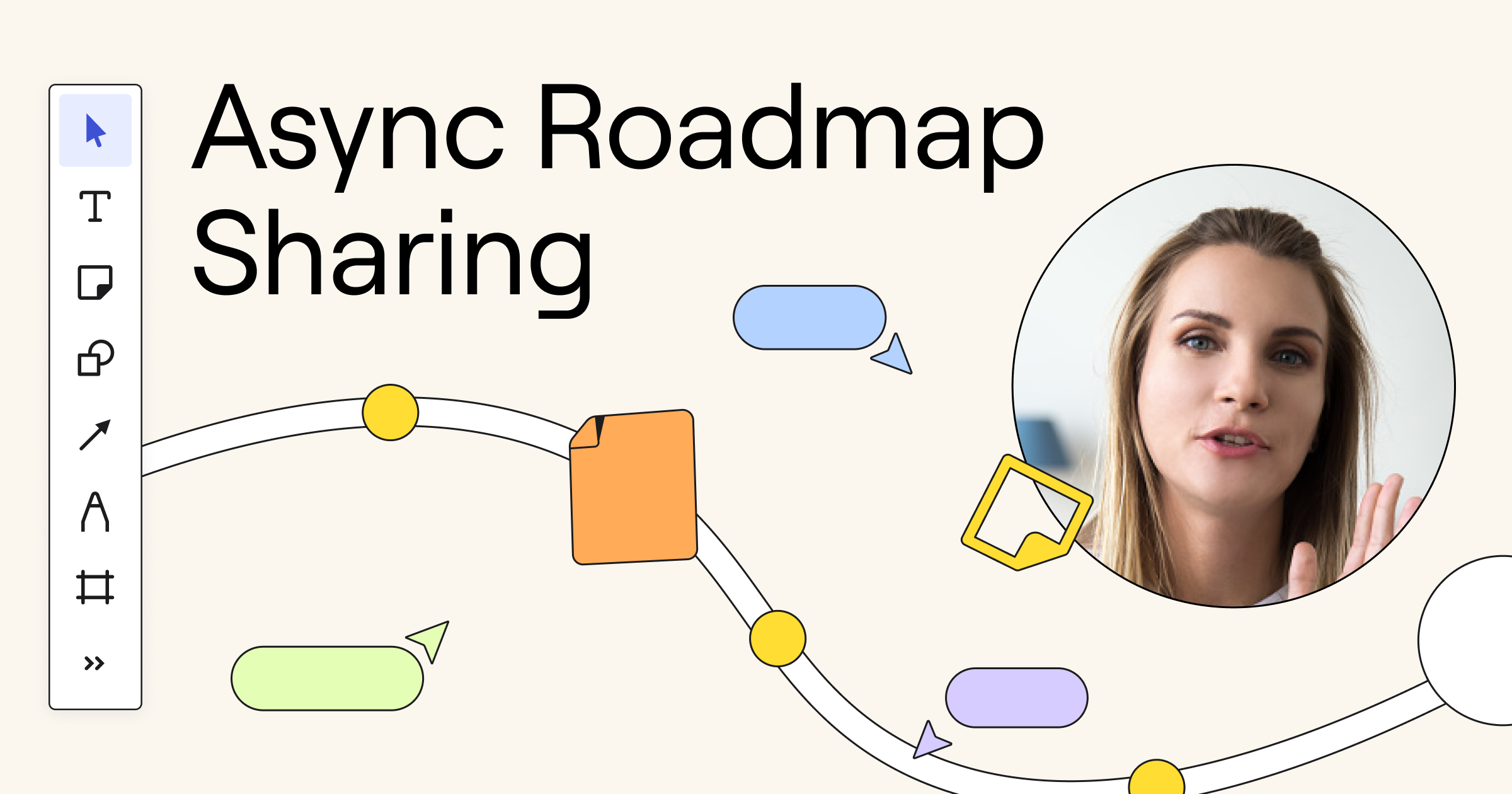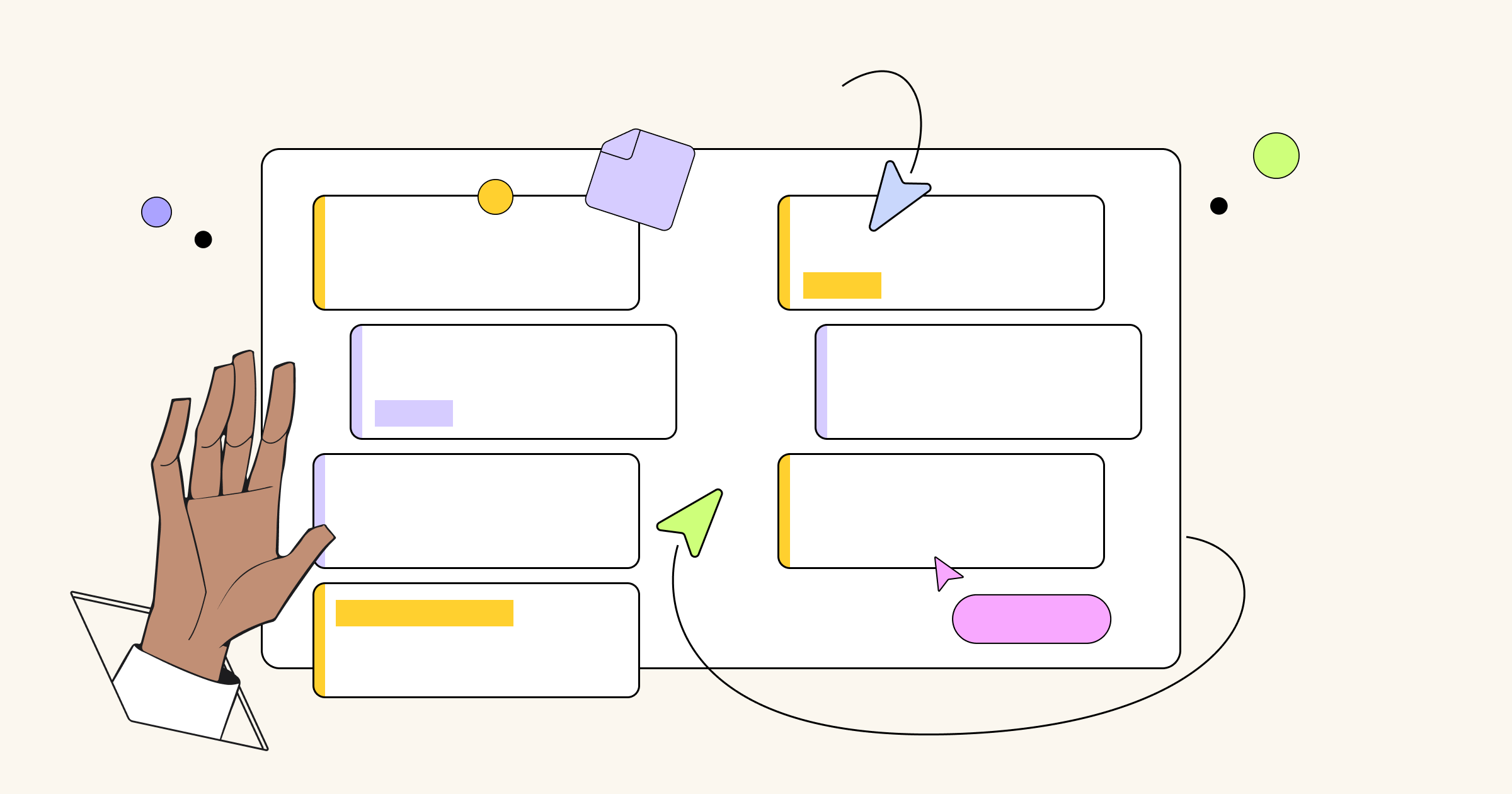Your product roadmap gets everybody on the same page about the vision and direction for your product — from what goals you’re aiming for to what features you’re working on (and what ones you’ll work on next).
It’s chock full of valuable information for your internal team members and external stakeholders. But that doesn’t make any difference if people can’t actually understand it.
Roadmaps can quickly become unwieldy. But with the right product roadmap templates and tools, you can create a resource that offers more clarity and less confusion.
Skip the spreadsheet: Why visual workspaces are better for roadmapping
Keeping track of your roadmap in a shared spreadsheet may be fine to start, but it can quickly turn into a tangled web of notes, random categorizations, and scattered add-ons that cause product teams to lose interest.
And if anybody from leadership or another team wants to take a peek, it’s like it’s written in another language.
A visual workspace like Miro brings much-needed simplicity to your roadmap. With arrows, shapes, sticky notes, colors, labels, stickers, and more, there are seemingly endless options to organize and connect information — making it far more intuitive and digestible than a crowded spreadsheet.
It’s easier to update, too. Anything from customer feedback to a new market insight could alter your roadmap. When that happens, it’s simple to find what you need and make the necessary changes, without combing through a messy spreadsheet or having to make the update in a dozen different places.
Miro also integrates directly with the tools your product team is already using (like Jira), so you can take action on your roadmap without all of the manual re-work of moving tasks and ideas over.
In short, your product roadmap is dynamic. Build it somewhere that embraces that fact, rather than limits it.
6 product roadmap templates you need to try
One game-changing benefit of using a virtual whiteboard like Miro for product roadmaps is the availability of templates. With a template, you’ll have a structure from the start, so you can focus less on organization and more on the actual content.
Here are six of our favorite product roadmap templates to get you started.
1. Shape your strategy with this Product Strategy Map template
Before you start hashing out specific features and to-dos, this Product Strategy template, created by Shyvee Shi, forces you to zoom out and understand the bigger picture.
As the Product Lead at LinkedIn, Shyvee knows a thing or two about what it takes to build winning roadmaps. In this template, she shares that insight and experience to help other product teams set themselves up for product-planning success.
You’ll use the template to outline all of the must-know information about your company, customers, competitors, market, differentiators, metrics, and more. With that foundation in place, use the checklists to ensure your strategy is buttoned up and then identify action items and decisions.
While this template doesn’t create your actual product roadmap, it’ll walk you through all of the important groundwork.
2. Stay focused on outcomes with this Product Roadmap (Now, Next, Later, Trash) template
Talk to anybody who’s created a roadmap before and they’ll quickly tell you that it’s easy to think about all of the things you want to get done, but much harder to stay focused on why they matter.
This Product Roadmap (Now, Next, Later, Trash) template, created by David Pereira, a well-known product leader, addresses that problem by spotlighting outcomes rather than outputs. That means it’s more prescriptive about what the team wants to achieve and less prescriptive about how they do it.
The template requires ruthless prioritization by sorting those outcomes into categories:=
- Now: Outcomes to chase in the next one to three months
- Next: Outcomes to chase in the next three to six months
- Later: Opportunities to consider for the future
- Trash: Outcomes or opportunities you’re not chasing
By sorting your priorities into these categories, you, your team, and your stakeholders can stay aligned on what matters most, rather than getting bogged down in details and task lists.
3. Provide transparency with this Agile Product Roadmap template
Your product team lives and dies by your roadmap, but they likely aren’t the only people referencing it. Outside teams and people — like sales, customer support, or even your customers — might want to stay in the loop about what you’re currently working on.
The product team at parenting app, Sesh, created this Agile Product Roadmap template to provide better transparency into in-progress initiatives. There are two different templates, so you can pick whether you want the one for two initiatives or four.
Regardless of which one you choose, the simple structure means everybody can readily see what the product team is focused on. It’s also flexible and easy to update, which means managing the roadmap doesn’t need to be a full-time job.
4. Stay true to your vision with this Product Roadmap template
If you and your team are into thematic roadmapping, this Product Roadmap template, created by Caterine Grief, Product Owner at Red Acre, is the one for you.
You’ll start by putting your product vision at the top. From there, you look at each quarter and group your objectives into overarching themes or categories. On the template, there’s also space to create your own stages (such as “prototype” and “standby”) and then note which stage each theme is in.
It’s a simple way to communicate your product’s intent and direction with your product team, as well as any stakeholders who need high-level information without the nitty-gritty details.
5. Get clear on your priorities with the Prioritized Product Roadmap template
If you’re like any other product team, everybody around you has a suggestion about how you could improve your product. The tough part is figuring out what to work on first.
This Prioritized Product Roadmap template, from Jānis Dirveiks, an Organizational Coach and Team Trainer, gives your team space and freedom to jot down all of those product issues or ideas.
When that brain dump is over, it’s time to get real about what matters most. You’ll move those sticky notes into a matrix to determine what’s a must-have, should-have, could-have, or will-not-have, as well as what should happen now, next, or later.
If your team struggles to process and take action on the barrage of feature requests that come your way, this template will help you bring much-needed order to the chaos.
6. Keep your eye on the prize with the Goals-Based Roadmap template
Sami Rehman, Product Manager at mobileLive and the creator of this Goals-Based Roadmap template, says it best: “Many companies keep rolling out roadmaps just for the sake of it. In most cases, these roadmaps turn the teams (and the organization) into incoherent feature-building factories with no goals, no strategy, and no eye on contributing towards the organization’s long-term vision.”
This template aims to change that by keeping the whole team focused on the vision, strategy, and goals rather than specific feature requests.
Don’t worry — there’s still space to hash out your features and metrics. But you’ll need to fill out the vision and strategy prompts and identify your goals before you get there, which helps you and your team be more strategic about the features you prioritize.
Build a better roadmap
Your roadmap is more than just a plan or a vision. When it’s done well, it’s your product team’s engine. But the information on your roadmap is only valuable if you (and other stakeholders) can actually make sense of it.
For that reason, it’s time to move beyond slapdash or siloed spreadsheets and into a workspace that’s just as dynamic as your roadmap itself. Start planning your next product roadmap with Miro.






